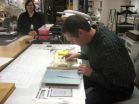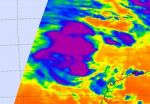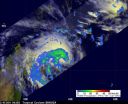(Press-News.org) ALBUQUERQUE, N.M. — A Sandia National Laboratories team helped reach a major milestone in the nation's nuclear nonproliferation efforts by working with the Central Asian country of Kazakhstan to move nuclear materials — enough to build an estimated 775 nuclear weapons — to safety.
Sandia provided security and logistics expertise to complete the transfer across Kazakhstan of spent fuel containing 11 tons (10 metric tons) of highly enriched uranium and 3.3 tons (3 metric tons) of weapons-grade plutonium that had been stored in a BN-350 fast-breeder reactor in the busy Caspian Sea port of Aktau in western Kazakhstan, said Dave Barber, who worked for Sandia's Global Physical Security Program at the time.
"We're making things safer in the world," Barber said. "Before it was protected, the materials were vulnerable to theft by those who would steal them to build nuclear weapons. This project has secured enough material to make 775 nuclear weapons. That gives us a great feeling and should make people feel much better."
The removal of the weapons-grade materials marks the completion of 14 years of work that began at Sandia in 1996.
The last concrete and steel cask was transferred to a long-term storage facility in northeast Kazakhstan on Nov. 18. The 1,860-mile journey to get the casks to their resting place there would be like traveling from Washington, D.C., to Albuquerque through a sparsely populated, moonscape-like steppe.
The National Nuclear Security Administration (NNSA) oversaw the project as part of its Global Threat Reduction Initiative (Photos here). In addition to Sandia, NNSA's team included Idaho, Los Alamos, Oak Ridge and Pacific Northwest national laboratories, the U.S. Defense and State departments, the Nuclear Regulatory Commission, the International Atomic Energy Agency, several contractors and the United Kingdom, Kazakhstan and Russia.
Sandia protected the fuel while it was stored at the BN-350 reactor and at a temporary, outdoor concrete storage pad in Aktau; along a journey by train across Kazakhstan to Kurchatov; while it was at another interim storage pad there; and along a truck route to a long-term concrete storage pad in northeast Kazakhstan.
Sandia conducted vulnerability studies that Barber used to brief Congress, the Pentagon, and members of the National Security Council.
Sandia, in conjunction with Albuquerque-based Technology Management Co., also provided extensive travel and international field logistics for the project, Barber said.
"The United States was very worried about this material not being protected well enough and that it could be stolen, so the United States offered to protect this material," Barber said. "In the interior, it would be much more difficult for adversaries to try to steal it."
The BN-350 at the Mangistau Atomic Energy Complex, which started operations in 1973, produced plutonium for the former Soviet Union's weapons program. The plant also provided 135 megawatts of electricity, 9 million gallons of water per day and steam for hot water and heating for Aktau. Since it was shut down by the Kazakh government in 1999, gas turbines generate the power, desalination of water and steam for the region.
The reactor sits on the eastern shore of the Caspian Sea. The bustling port is a point of departure for ships carrying oil from Kazakhstan to Baku, Azerbaijan, where it enters pipelines that take it to Europe.
The fuel rods were placed into canisters, which were then put into 60 100-ton concrete and stainless steel casks. The casks were stored on a pad outside the reactor before being loaded into shipping containers to make the four-day train journey to Kurchatov, where they would be unloaded and placed onto trucks for the trip to their long-term storage facility.
Sandia worked with Kazakhstan's Ministry of Interior troops, providing them with technical advice, communications equipment and other support, Barber said.
To make sure all would go smoothly, in December 2009, Barber was one of three Americans who traveled on the train during a dry run to ensure that the security plan worked, that the loading and unloading of the casks went off without a hitch and that communications were reliable.
John Franklin of Sandia's National Security Studies Department researched options for procuring two railcars that carried guards on the train, one serving as a backup in case the other was hit. Before the train left, rail crews checked the thousands of miles of tracks for explosives. The trains were given top priority as they crossed the country, Barber said.
During that four-day train ride, Barber said he looked for changes in the terrain that adversaries could use to attack the trains along the route. He needn't have worried.
"What we found was that one end of Kazakhstan looks much like the other end. It was very flat, no real hills, few trees," he says. "We could count the number of trees."
The real runs started in February, and the dozen trips from Aktau to Kurchatov and then to the final location went smoothly, Barber said.
"There were no incidents during the hot runs when we had the fuel in there," Barber said. "We count that as a success."
INFORMATION:
Sandia National Laboratories is a multiprogram laboratory operated by Sandia Corporation, a wholly owned subsidiary of Lockheed Martin Corporation, for the U.S. Department of Energy's National Nuclear Security Administration. With main facilities in Albuquerque, N.M., and Livermore, Calif., Sandia has major R&D responsibilities in national security, energy and environmental technologies, and economic competitiveness.
Sandia security experts help Kazakhstan safely transport, store Soviet-era bomb materials
2011-02-14
ELSE PRESS RELEASES FROM THIS DATE:
Wayne State study: Enhance romance by going out with other couples
2011-02-14
DETROIT— Romantic relationships often start out as enjoyable or even exciting, but sometimes may become routine and boring. A Wayne State University study reveals that dating couples that integrate other couples into their social lives are more likely to have happy and satisfying romantic relationships.
Richard B. Slatcher, Ph.D., assistant professor of psychology in WSU's College of Liberal Arts and Sciences and a resident of Birmingham, Mich., specializes in social and health psychology. His recent research suggests that spending quality time with other couples may ...
VCU Massey first to combine targeted agents to kill multiple myeloma cells
2011-02-14
Richmond, Va. (Feb. 10, 2011) – Scientists at Virginia Commonwealth University Massey Cancer Center have developed a novel treatment strategy for multiple myeloma that pairs two targeted agents to kill cancer cells. The study's findings, published in today's edition of the journal "Blood," are the first to demonstrate the synergistic, anti-myeloma effects of this combination regimen both in vitro and in vivo.
Multiple myeloma is a cancer involving antibody-producing cells in the bone marrow, and, in most cases, is incurable. Targeted therapies work by interfering with ...
University of Arizona experts determine age of book 'nobody can read'
2011-02-14
University of Arizona researchers have cracked one of the puzzles surrounding what has been called "the world's most mysterious manuscript" – the Voynich manuscript, a book filled with drawings and writings nobody has been able to make sense of to this day.
Using radiocarbon dating, a team led by Greg Hodgins in the UA's department of physics has found the manuscript's parchment pages date back to the early 15th century, making the book a century older than scholars had previously thought.
This tome makes the "DaVinci Code" look downright lackluster: Rows of text ...
Powerful new ways to electronically mine research may lead to scientific breakthroughs
2011-02-14
The Internet has become not only a tool for disseminating knowledge through scientific publications, but it also has the potential to shape scientific research through expanding the field of metaknowledge—the study of knowledge itself.
The new possibilities for metaknowledge include developing a better understanding of science's social context and the biases that can affect research findings and choices of research topics, according to an article published by University of Chicago researchers in the journal Science. Pooling research-related information online can shed ...
Roses get celery gene to help fight disease
2011-02-14
A rose by any other name would smell … like celery?
North Carolina State University research intended to extend the "vase life" of roses inserts a gene from celery inside rose plants to help fight off botrytis, or petal blight, one of the rose's major post-harvest diseases.
Some fungal pathogens, the bad guys that infect plants, produce a sugar alcohol called mannitol that interferes with the plant's ability to block disease like petal blight, which produces wilty, mushy petals – an effect similar to what happens to lettuce when it's been in the crisper too long.
In ...
JPEG for the mind: How the brain compresses visual information
2011-02-14
Most of us are familiar with the idea of image compression in computers. File extensions like ".jpg" or ".png" signify that millions of pixel values have been compressed into a more efficient format, reducing file size by a factor of 10 or more with little or no apparent change in image quality. The full set of original pixel values would occupy too much space in computer memory and take too long to transmit across networks.
The brain is faced with a similar problem. The images captured by light-sensitive cells in the retina are on the order of a megapixel. The brain ...
Study examines phenomenon of women caring for ex-husbands
2011-02-14
COLUMBIA, Mo. – The aging population, 65 years and older, includes nearly 3.8 million divorced men and women, according to the U.S. Census Bureau. Illnesses and end-of-life issues can be particularly difficult for singles without spouses or designated caregivers. A new study from the University of Missouri provides insight into the experiences of exes who care for their former spouses, offering support, assistance with daily tasks and management of health needs.
"The concept of women as caregivers for their ex-husbands is largely unexplored," said Teresa Cooney, associate ...
NASA infrared satellite data gives System 96S a fair shot at becoming a tropical cyclone
2011-02-14
A low pressure area located a couple of hundred miles northwest of Western Australia appears in a better position for development into a tropical cyclone according to infrared NASA satellite imagery. Infrared imagery from NASA's Aqua satellite shows some strong convection in the low, named System 96S.
When Aqua passed over System 96S on Feb. 9 at 17:47 UTC (12:47 p.m. EST), the Atmospheric Infrared Sounder (AIRS) instrument showed some strong convection and strong thunderstorms with very cold cloud-top temperatures around the center of circulation. Those cloud top temperatures ...
WSU researcher designs multilingual instruction materials for world's largest mall
2011-02-14
Housing 1,200 stores, an underwater zoo, a SEGA indoor theme park, an Olympic-size ice rink, a 22-screen Cineplex and the world's largest gold market, the Dubai Mall is a retail marvel that attracts tourists from around the world. Thanks to one Wayne State researcher, its multilingual, multicultural employees are using an efficient, cost-effective instructional process to learn their job duties.
Monica W. Tracey, Ph.D., associate professor of instructional technology and administrative and organizational studies in WSU's College of Education and resident of Farmington ...
2 NASA satellites see a newborn tropical storm near Madagascar
2011-02-14
Forecasters at the Joint Typhoon Warning Center were keeping a close eye on a low pressure area known as System 94S yesterday, and satellite data helped confirm that today it has strengthened into Tropical Storm Bingiza.
The Moderate Resolution Imaging Spectroradiometer (MODIS) instrument aboard NASA's Terra satellite captured this image of Tropical Storm Bingiza at 06:30 UTC (1:30 a.m. EST) on its approach to Madagascar. The highest, strongest thunderstorms appeared almost bubble-like near the center of the storm's circulation.
The Tropical Rainfall Measuring Mission ...






